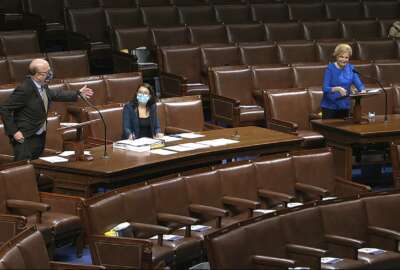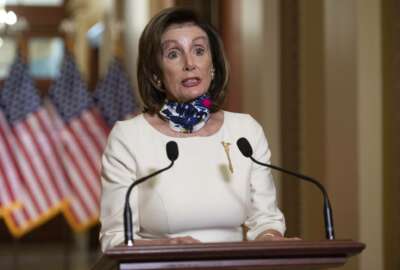
What’s in the stimulus bills for the federal workforce?
For some of the prospects, WTOP congressional correspondent Mitchell Miller joined Federal Drive with Tom Temin.
Best listening experience is on Chrome, Firefox or Safari. Subscribe to Federal Drive’s daily audio interviews on Apple Podcasts or PodcastOne.
House Democrats appear to pass a $3 trillion stimulus bill – a second $3 trillion stimulus bill. It spreads money pretty much everywhere. But it also has provisions dealing with the federal workforce and with federal contractors. For some of the prospects, WTOP congressional correspondent Mitchell Miller joined Federal Drive with Tom Temin.
Interview transcript:
Tom Temin: And Mitchell, where do we begin this bill? There’s money for every agency, but also a lot of non-money provisions and tell us more.
Mitchell Miller: Right, so it only spans some 1,800 pages, but let’s try to dive in on a few of the things that really affect federal workers. It does require agencies to keep allowing telework for eligible employees as well as contractors during the pandemic. It also urges agencies to expand telework and requires goals to increase the numbers of those who telework, any agency that would limit telework would need to give advance notice to OPM and Congress. So clearly, still more of a focus as we’ve been talking about over the last several weeks and months on that emphasis on getting people to work from home. Now also one of the biggest parts of it related to federal workers involves the $200 billion HEROES fund. It covers federal employees as well of course, as people in the private sector. Essential workers would get an additional $13 an hour in addition to their regular wages. That would go up to $10,000. And then for really high earners, it would only go to another $5,000. Also, if an essential worker dies of COVID-19, the worker’s family would receive the remainder of the pay. Federal law enforcement officers would be able to keep retirement benefits if they get the virus and can’t meet the physical demands of their jobs and OPM makes the final decision of course on which federal workers qualify for hazard pay. Teleworkers would not be eligible. Congress is appropriating an extra $10 billion to help cover the costs of premium payments for the federal employees.
Tom Temin: I guess it’s fair to say that even though the $3 trillion dollars in spending is not a bipartisan issue, when it comes to telework, pretty much that has had support from both sides of the aisle, even though the Trump administration has really, frankly tried to tamp down as much as it can on federal telework.
Mitchell Miller: Right, that’s one of the issues that really both parties have shared. You know, we’ve talked about Virginia Congressman Gerry Connolly on the Democratic side has really pushed hard to make sure that all these agencies are sustaining telework. And on the Republican side too, lawmakers are saying, look, we’ve got to have people working from home, we really have no other choice. So this is one of those areas where you have had bipartisan support, sort of like the Paycheck Protection Program within the Small Business Administration – both parties agreeing to you know, varying degrees, they’re going to have some differences on certain issues related to it. But they both say that this has to be done. These are things that need to be assisting small businesses, for example, they need to have some kind of lifeline as we move through this period of reopening and whether or not they’re even able to sustain themselves after we come out on the other end of the pandemic.
Tom Temin: We’re speaking with congressional correspondent Mitchell Miller of WTOP. Now the Senate Majority Leader Mitch McConnell has said this ain’t gonna go anywhere. But could they possibly break it down into things where they do agree and get those passed? For example, I don’t think the Republicans would go for the $500 billion in aid to local and state governments. But they could go for maybe some of the appropriations to help agencies with initiatives. And some of these, as you say, workforce provisions.
Mitchell Miller: Right. The Democrats are basically throwing this out as a massive bargaining chip. Even House Speaker Nancy Pelosi has indicated that this is really the start of negotiations. They want to put this down as a marker and say to the American people, okay, this is what we as Democrats want to do. Republicans obviously have a lot of their own ideas. McConnell has made it clear he wants to make sure that there’s protection for businesses so that they don’t get sued and have a lot of liability issues as we go through the pandemic, but also Republicans have a lot of different proposals related to, as you mentioned, helping agencies making sure that all of these federal agencies stay on track as we work through the reopening process. And by the way, related to the reopening process, the federal government is basically taking a go slow approach here in the Washington area, as you have Maryland and Virginia counties, and many of the suburban areas moving slowly along with the statewide efforts in Maryland, Virginia. Also, of course, D.C. – the mayor has extended to stay at home order until June 8. So as federal agencies are being urged to maximize that telework through this so called gating period as we move through phase one of the reopening, in addition to continuing extensive telework, flexible work schedules have to be continued to be used. Many federal organizations are utilizing federal work schedules and teams so they can be – there can be social distancing in their offices. For example, I spoke to a committee staffer here on the Hill who alternates with another team member each week. So they’ve been able to get work done here at the Capitol, but also work from home. And then many staff members from Congress, of course, continue to work for home. As we’re getting ready to get people back into the office in these federal agencies, kind of the nitty gritty there, the GSA’s public building service, as Federal News Network has reported has been disinfecting sites where federal workers have tested positive for COVID-19. Getting some of those offices ready for eventual return of employees.
Tom Temin: So with the differences between the counties in the District, you could see crowds may be on the metro at White Flint and New Carrollton, but not at L’Enfant Plaza?
Mitchell Miller: Right, exactly. And then, of course, Metro itself is moving back very slowly. Metro has announced that it really is not going to get back into “normal operations” until next year. And so of course, with so many federal workers using those stations, as you mentioned, that’s going to have to figure into how they’re going to decide to move forward at the highest levels of these federal agencies because obviously, if people can’t get to work, they can’t get physically in their offices.
Tom Temin: And finally, what about the possibility of the technology allowing Congress to work more remotely as a matter of course? That’s been controversial, too.
Mitchell Miller: That’s a really interesting issue. I mean, this really goes to the fundamental issue of what a Congress is right? Opponents of remote voting, and many of them Republicans say they should be doing the people’s business here at the Capitol, that there is really no choice that that is what a Congress is. You come here to Washington to represent hundreds of thousands. Generally, the average is about 750,000 people per district for all of these members of Congress. And what they are saying is you’re making a fundamental -and some argue a constitutional change that shouldn’t be made. On the other side, many Democrats and some Republicans say that you need to have some kind of reaction to what has happened with this pandemic. So this remote voting measure that the House has passed, basically says that you can have proxy voting so you can have up to 10 members that you can vote for remotely from wherever you are. There are also big changes coming related to how the committees do oversight, and that also led to a lot of back and forth between lawmakers, both Republicans and Democrats, they switch sides on this. A lot of them respectively, both agree that something has to be done. So there, you’re going to see a lot more of these remote committee meetings. We saw some of them in the past week where many of the members were joining from literally across the country. And they seem to have actually pretty quickly adapted to this just as many businesses and people working from home have. And so the the real issues are going to be the tough ones on some of those highly secure committees. You know, the the intelligence committees, the armed services committees, how do they lock down the information that’s going out? And then some more practical issues as some pointed out, the chairman – sometimes it’s hard enough to control a committee as you know, just within a hearing room. Imagine when you have 12, 20, 30, 40 members all logging from various remote sites, and you’re trying to balance the time of each of the members. So a lot of issues to be worked out, but certainly a historic change here at the Capitol.
Tom Temin: I guess if people can do Zoom cocktail meetings, then people can have Zoom remote committee hearings. Mitchell Miller is senior congressional correspondent for WTOP. As always, thanks so much.
Mitchell Miller: You bet.
Tom Temin: We’ll post this interview at www.FederalNewsNetwork.com/FederalDrive. Subscribe to the Federal Drive at Apple Podcasts or Podcastone.
Copyright © 2024 Federal News Network. All rights reserved. This website is not intended for users located within the European Economic Area.
Tom Temin is host of the Federal Drive and has been providing insight on federal technology and management issues for more than 30 years.
Follow @tteminWFED
Related Stories





